11 Best first-time Europe itineraries for 1, 2, or 3 weeks
Europe is going to be very busy in the summer of 2024 as the world is back to normal and travel demand is higher than ever. One other key factor is that most European currencies are still hovering at lower levels historically compared to the US dollar, which means that Europe will feel somewhat cheap again this year. In fact, according to our World Backpacker Index, European cities like Lisbon, Madrid, and Munich are about 30% cheaper to visit than Boston, Chicago, and New York City. In other words, flying to Europe might seem expensive, but most things will be cheaper once you get there compared to the costs of visiting a large US city.
Below you’ll find 11 of the most popular and best itineraries for a first visit to Europe. Your first visit is not really the time to be different or creative, and the famous destinations tend to be popular for a reason. In other words, it’s kind of silly to visit, say, Bulgaria, if you’ve not yet been to France or Italy. I lay out the best options along with how long to stay in each place as a general guide. I also discuss Mediterranean cruises, which can actually be an amazing way to see a lot of Europe on your first visit, especially if you don’t like going back and forth to train stations and airports every 2 or 3 days.
For a bit of fun you might be interested in the cheapest 5-star hotels in Europe, which start at US$80 per night for really nice hotels. It helps show that if you choose some of the cheaper cities, you can treat yourself to some luxury that you can’t afford in most other places.
This article was last updated in March, 2024.
There are 11 starter itineraries described in detail below
- Classic London and Paris
- England and Scotland
- Paris and Italy
- Mediterranean cruise
- France, Belgium, and Netherlands
- Paris and elsewhere in France
- Italy
- Spain
- Germany
- Switzerland
- Best of cheap eastern Europe
For each itinerary there are suggestions of other destinations that are easy to add on to the main cities.
Note: This article was most recently updated in March, 2024
Building the best itinerary for your first trip to Europe
Below there are 11 popular itineraries for one week in Europe. If you’ve only got a week then choose one of them and assume you’ll return again to conquer more of this amazing part of the world. If you’ve got more time then you can choose from some of the top add-on suggestions for each one.
Start in the most famous cities
Your first visit to Europe is no time to try to be different or edgy. I recommend that you focus on these 5 great cities before you start branching out into cheaper or more obscure places.
Keep your travel days to a minimum
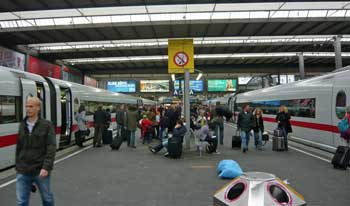
Spend 3 (or 4) nights in almost every major city
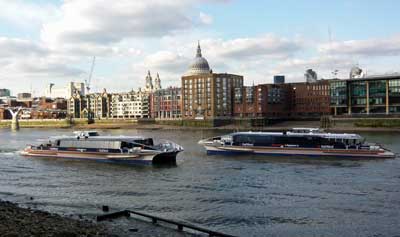
So many first-time visitors are initially planning on spending only 1 or 2 nights in major cities that I wrote a detailed explanation of why 3 nights is ideal for almost all European cities, even if you want to see as much as possible.
3 (or 4) nights will be enough for any city on your first trip
Most first-time visitors are tempted to move too quickly, but it can also be a mistake to move too slowly. It’s really amazing how much you can see in two full sightseeing days. If you spend too long in one city you’ll end up seeing things that are way down your list, while you could be in another city seeing things at the top of your list there.
Choose cities that are easy to reach from each other
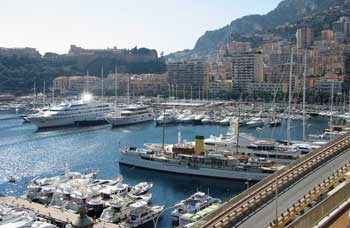
For your first trip it’s best to visit cities that are no more than a 5-hour train ride apart.
Choose cities that are connected by reasonable train rides rather than flights
To build on the point above, finding cheap flights within Europe is easy, but train travel is about a million times more enjoyable and less stressful. You’ll enjoy the train rides almost as much as the cities, so focus on places that are within 5 hours of each other by train.
Start with one of the classic itineraries below, and then add to it if you have more time
If you only have 7 days then you’ll find a list below of classic itineraries that are well-suited to a first visit to Europe. Hopefully you have more than 7 days though, and if you do you can add in one or more of the suggested add-on cities to build an itinerary that appeals most to you.
Best 1-week itineraries for the first time in Europe
Itinerary 1: Classic London and Paris
Fly into either city and take the 2-hour Eurostar train between them
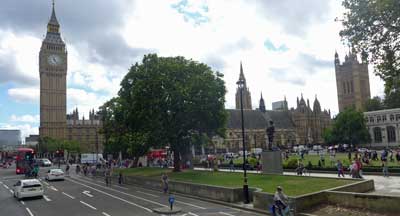
London highlights
- Big Ben and Parliament
- Westminster Abbey and St. Paul’s Cathedral
- Tower of London and Tower Bridge
- West End shows (Broadway equivalent) and classic pubs
- Buckingham Palace and Windsor Castle
Paris is actually far more beautiful than London and the food is famously much better as well. Since Paris gets so many tourists from non-French speaking countries, it’s easy to get by on just English, and the Metro system makes it fast and easy to get around. The architecture of both cities is amazing from the Tower of London, Big Ben, Westminster Abbey to the Louvre and the Eiffel Tower. These cities each pack a huge punch and they are very different from each other as well. Actually, England is arguably the best choice for your first trip to Europe.
Paris highlights
- Eiffel Tower
- Louvre Museum and Museum de Orsay
- Arc de Triomphe and other monuments
- Montmartre neighborhood and Sacré Coeur Cathedral
- Probably the world’s best affordable restaurants and wine
Best add-ons to London and Paris
- Edinburgh (2 or 3 nights, from London)
- Amsterdam (2 or 3 nights, from Paris)
- Bruges and Brussels (2 nights, from Paris)
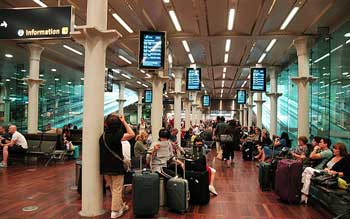
>>>Best one-week London and Paris itinerary in detail
>>>Check London hotel deals
>>>Check Paris hotel deals
Itinerary 2: England and Scotland
- London (3 or 4 nights)
- York (1 night)
- Edinburgh, Scotland (2 or 3 nights)
- Inverness, Scotland (2 or 3 nights)
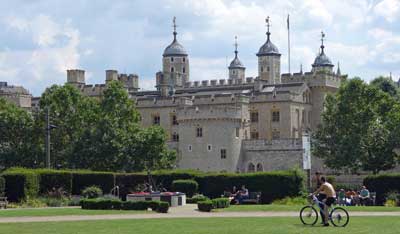
York is a small Roman city with intact city walls and one of the most famous cathedrals in Europe. Edinburgh is not only the capital of Scotland, but it’s easily the second most interesting city in all of Britain. If your time is short, skip York and spend more time in Edinburgh.
If you prefer to focus on the south of England on your first trip then the best option is to go to Bath or nearby Bristol after London. Bath is another of England’s top destinations and it’s a gorgeous city that has been a spa resort for many centuries. It’s also reasonably close to Stonehenge. You can also easily get to Cornwall in England’s southwest corner from Bath, and that’s a whole different and fascinating experience (with nicer weather than up north).
If you’ve got more than a week and want to spend more time in Scotland, especially in the summer months, the place to head to is Inverness. It’s a small town that is considered the gateway to the Scottish Highlands, but it’s an interesting and charming place on its own. You can take day-trips by bus to the highlights of the Highlands including the Isle of Skye and Loch Ness. Between you and me, it’s better to minimize time in Loch Ness or skip it altogether because it’s not one of the more photogenic parts of Scotland and the monster has always been a hoax.
Travel times between the recommended places
- London to York by train: 2 hours
- York to Edinburgh by train: 2.5 hours
- London to Edinburgh by train: 4 hours
- Edinburgh to Inverness by train: 3.5 hours
- London to Bath by train: 85 minutes
Best add-ons to England and Scotland
If you think you want to spend your whole trip in Britain you should have a look at our article on the best itineraries in England, Scotland, and Wales.
>>>Check London hotel deals
>>>Check Edinburgh hotel deals
Itinerary 3: Paris and Italy
- Paris (3 or 4 nights)
- Venice (1 night)
- Florence (2 or 3 nights)
- Rome (3 nights)
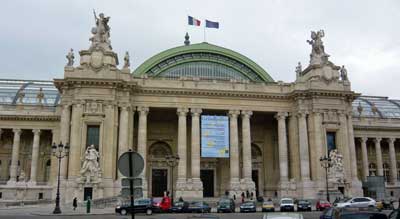
From Paris you can easily fly to Venice (or nearby Treviso) where you should try to spend about 24 hours. Venice is small enough to see in a full day, and so crowded that most people are satisfied to leave after that day. The key is to stay in the main part of the main island so you can enjoy Venice before the cruise passengers and day-trippers arrive, and also after they leave for the day. Two nights in Venice would not be wasted time, and it’s possibly the most gorgeous city in the entire world, but you can see the best of it in a bit over 24 hours.
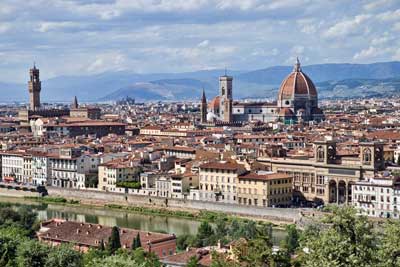
Rome also lives up to the hype and spending a day in the Vatican City will be a highlight even for non-Catholics, but it’s also a crowded and busy city so three days is usually enough for most people. Similar to Paris, Rome is an unusually beautiful city from almost any angle when you are in the historical center. You’ll walk through a stunning piazza (town square) and then turn a corner and you’ll see gorgeous buildings or public statues that are as nice as anything in the museums. Seriously, it’s worth a visit.
Paris to Venice flight: 1 hour 35 minutes
Venice to Florence by train: 1 hour 53 minutes
Florence to Rome by train: 1 hour 16 minutes
You can of course instead fly from Paris to Rome and then go north to Florence and then to Venice and fly home (or back to Paris) from there, and it would be just as enjoyable.
Best add-ons to Paris and Italy
France
- Nice/Cannes/Monaco (2 or 3 nights)
- Avignon (2 nights)
- Bourges (2 nights)
- Bordeaux (2 nights)
- Aix-en-Provence (2 nights)
- Reims (2 nights)
- Dijon/Burgundy (2 nights)
Italy
- Milan (1 or 2 nights)
- Lake Como (2 nights)
- Siena (2 nights)
- Cinque Terre (1 night)
- Naples/Sorrento/Amalfi Coast/Pompeii/Capri (3 to 5 nights)
- Sicily (3 to 4 nights)
>>>Much more information in this article about the best France and Italy itineraries
>>>Check Paris hotel deals
>>>Check Venice hotel deals
>>>Check Florence hotel deals
>>>Check Rome hotel deals
Itinerary 4: Mediterranean cruise
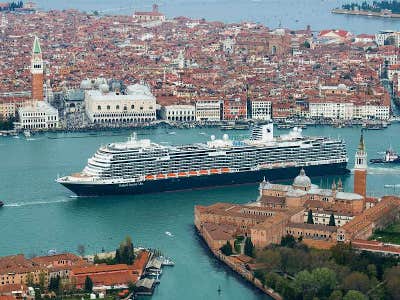
In spite of the reputation of cruises to be floating buffets, they can actually be an excellent way to visit a great number of amazing European cities in a short time. The ship typically is in port from the early morning until mid evening, often giving you the opportunity to have dinner in the city (unlike Caribbean cruises). Better still, the cruise ports are often near the center of town, so you can just walk off the ship and do sightseeing on foot or by public transportation.
Mediterranean cruises usually start at 7 nights but can go up to 3 weeks, which can provide an amazing tour of the entire region without having to pack and repack your bags more than once. They also can provide excellent value, especially compared to the price of taking trains or flights and finding new hotels in every destination.
Most popular Mediterranean departure ports
Barcelona, Spain – It’s an easy port to reach. Ships generally go from Barcelona with stops in France and then Italy.
Rome (Civitavecchia), Italy – The port isn’t very close to Rome, but it’s easy to get back and forth. Ships go west to France and Spain as well as south around the tip of Italy and then on to Croatia, Venice, and to Greece.
Venice, Italy – The cruise ships no longer dock close to the best tourist areas, but it’s easy enough to visit Venice for a day or two before boarding a ship. Ships starting in Venice go south and then head west and to Rome and then to France, or they go south to Croatia and then head east to Greece.
Athens, Greece – The cruise port of Piraeus is just south of Athens and easy to reach. Ships from Athens usually head west towards Croatia, Italy, France, and Spain, but there are also ships that visit Greek islands and Turkey.
>>>Check for deals on Mediterranean cruises
Alternative to consider: a river cruise
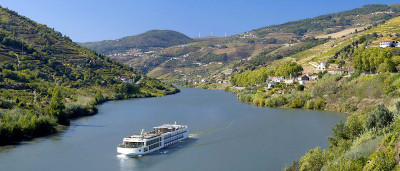
Amsterdam, Budapest, and Prague are some of the most popular river cruise ports, but there are dozens of others including many smaller towns in France where few other tourists will be when you stroll off the ship. There is little or no entertainment on the river cruise ships, but passengers don’t miss it because the entire day and into the evening is spent just steps from local cultural offerings and restaurants.
>>>Check for Europe and river cruise deals
Itinerary 5: France, Belgium, and Netherlands
Paris to Brussels: 1 hour 22 minutes
Brussels to Bruge: 58 minutes
Bruges to Amsterdam: 2 hours 45 minutes
Amsterdam to Paris: 3 hours 17 minutes
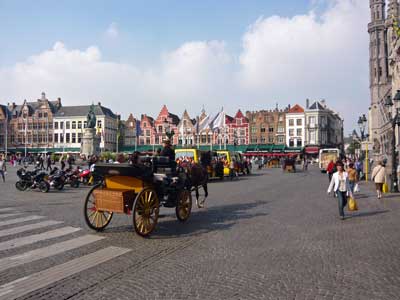
Spending 4 nights in Paris and 3 nights in Amsterdam would be a great trip, but if you want to see something else you’ve got a couple options in between. My advice is to spend an afternoon looking around the Grand Place (main square) in Brussels and then hop a 58-minute train ride to Bruges for a night or two. Brussels isn’t a great tourist city, but Bruges really is so it’s a better option for most people. Whatever you choose out of this group, you can be back in Paris on another high-speed train for your flight home.
Best add-ons to France, Belgium, and Netherlands
- Luxembourg City (1 or 2 nights)
- Cologne, Germany (1 or 2 nights)
- London (3 or 4 nights)
- Interlaken, Switzerland (2 or 3 nights)
>>>Check Paris hotel deals
>>>Check Bruges hotel deals
>>>Check Amsterdam hotel deals
Itinerary 6: Paris and elsewhere in France
- Paris (3 or 4 nights)
And a choice of:
- Nice/Cannes/Monaco (2 or 3 nights)
- Avignon (2 nights)
- Bourges (2 nights)
- Bordeaux (2 nights)
- Aix-en-Provence (2 nights)
- Reims (2 nights)
- Dijon/Burgundy (2 nights)
- Normandy (2 nights)
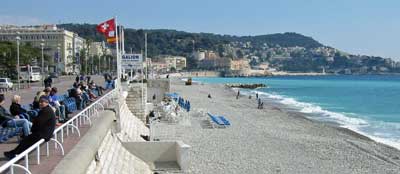
While Nice is a wonderful tourist city for a look at the French Riviera, the other larger cities of Lyon and Marseilles are probably better saved for a future trip because they are light on key sights compared to many smaller towns. Wine lovers can rent a car or take trains into Bordeaux or Burgundy. Since you can get between most of these towns by train in 2 hours or less, spending only 2 nights in each one is a reasonable option if you want to see a lot in a short time.
Normandy is an interesting choice and easy to reach in only about two hours by train from Paris. Some visitors like to see the famous WWII beaches and memorials, while others (especially in summer) like to check out one or more of the beach-resort towns. Deauville is one of the more famous of those, and it’s also famous for its horse race track and as one of the epicenters of the industry in Europe.
Best add-ons to Paris and elsewhere
- More France, of course
- London (3 or 4 nights)
- Interlaken, Switzerland (2 or 3 nights)
- Amsterdam (2 or 3 nights)
>>>Check Paris hotel deals
>>>Check Nice hotel deals
Itinerary 7: Italy
Rome to Florence: 1 hour 16 minutes
Florence to Venice: 1 hour 53 minutes
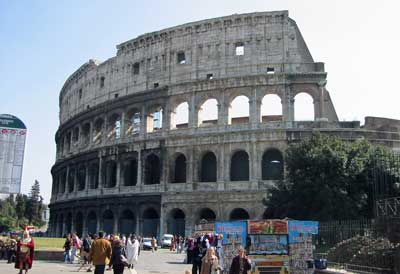
Venice is small enough that you can see the main sights in about 24 hours, and it’s so insanely crowded that many people tire of it after about a day as well. It’s better to pay more for a hotel to be on the main island and visit quickly than to save money with a hotel on the mainland where you’ll be in crowds going back and forth as well. Florence is the most relaxing of the 3, and also a great base for side trips to Pisa, Siena, and Cinque Terre, just to name a few.
Going to Italy? Here are the best first-time Italy itineraries for 3 days to 2 weeks (in much greater detail)
Best add-ons to Italy
- Milan (1 or 2 nights)
- Lake Como (2 nights)
- Siena (2 nights)
- Cinque Terre (1 night)
- Naples/Sorrento/Amalfi Coast/Pompeii/Capri (3 to 5 nights)
- Sicily (3 to 4 nights)
>>>Check Rome hotel deals
>>>Check Florence hotel deals
>>>Check Venice hotel deals
Itinerary 8: Spain
Madrid to Barcelona: 2 hours 30 minutes
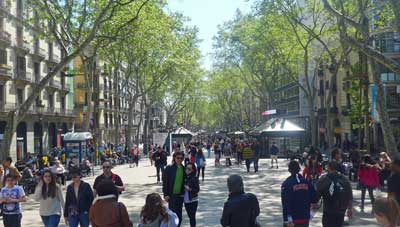
A huge part of Spain’s tourism industry is built around its southern beaches and islands such as Ibiza, Mallorca, and Tenerife (in the Canary Islands). For most people it’s best to ignore those places on your first trip because none of the beaches are special enough to spend days on them compared to the culture of the cities.
Best add-ons to Spain
By popular demand, I’ve added a full article on where to go in Spain with itineraries from 7 to 10 days up to two weeks.
>>>Check Madrid hotel deals
>>>Check Barcelona hotel deals
>>>Check Lisbon hotel deals
Itinerary 9: Germany
Berlin to Munich: 6 hours 2 minutes
Munich to Rothenburg ob der Tauber: 2 hours 56 minutes
Munich to Füssen: 2 hours 4 minutes
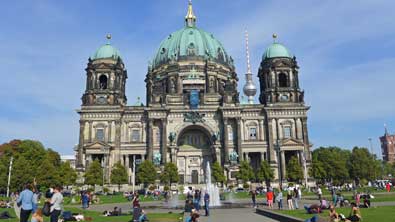
Those two cities are the keys to a Germany visit, and after that you’ve got a wide variety of choices. I cover most of the popular choices in my article on where to go in Germany, which covers several smaller towns that are major highlights.
Best add-ons to Germany
- Cologne (1 or 2 nights)
- Hamburg (2 or 3 nights)
- Amsterdam (3 nights)
- Prague (3 nights)
- Salzburg (2 or 3 nights)
- Vienna (3 nights)
- Interlaken, Switzerland (3 nights)
- Lucerne, Switzerland (2 or 3 nights)
>>>Check Berlin hotel deals
>>>Check Munich hotel deals
Itinerary 10: Switzerland
- Interlaken (3 nights)
- Bern (1 night)
- Lucerne (3 nights)
Zurich Airport to Interlaken: 2 hours 10 minutes
Interlaken to Bern: 53 minutes
Bern to Lucerne: 1 hour 50 minutes
Lucerne to Zurich Airport: 1 hour 3 minutes
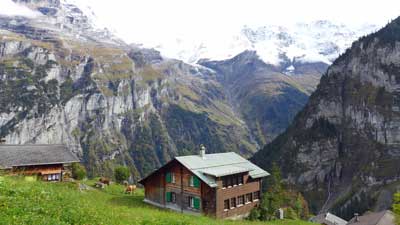
Interlaken is the best hub for the most dramatic Alps views and experiences. The one-hour cable car ride up to the Schilthorn observation deck is something you’ll never forget, and the only thing that might be more dramatic is the train ride up to the Jungfraujoch station, which is the highest in Europe. Lucerne is almost as beautiful with a scenic lake at its heart and also great mountaintop views nearby. If you do want to see a Swiss city then the capital of Bern is the most interesting and photogenic on a short visit. Read more about where to go in Switzerland for even more ideas.
Best add-ons to Switzerland
>>>Check Interlaken hotel deals
>>>Check Lucerne hotel deals
Itinerary 11: Eastern Europe’s best cheap cities
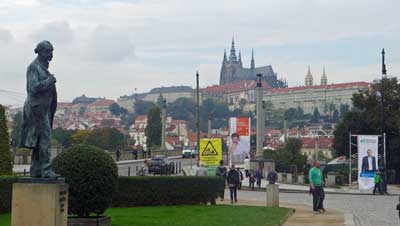
Each of these cities is beautiful and historic, but English is less widely spoken so they can also be quite a bit more challenging for a first-time visitor. Another difficulty is that the trains between them are still quite slow compared to the high-speed rail in the West, so it takes most of a day from one to another, and a bus is often a better choice. I cover this best cheap Europe itinerary more fully in the linked article.
Prague to Budapest: 6 hours 41 minutes
Budapest to Krakow: 9 hours 54 minutes (flying might be better)
Best add-ons to cheap Eastern Europe
- Cesky Krumlov, Czechia (2 nights)
- Ljubljana, Slovenia (2 or 3 nights)
- Split, Croatia (3 nights)
- Belgrade, Serbia (2 or 3 nights)
- Sarajevo, Bosnia and Herzegovina (2 or 3 nights)
- Sofia, Bulgaria (2 or 3 nights)
>>>Check Prague hotel deals
>>>Check Budapest hotel deals
>>>Check Krakow hotel deals


Comment*Hi! I’m starting to plan our first family trip to Europe. I actually do not know where to begin and I’m glad I found your post. All the information are helpful. We would like to visit France, Italy, and Spain. Are all these doable by train? Where do you suggest we start (flying from Los Angeles)? How many days should I allot for each country? How much should I budget per person (3 adults and 1 teen)? Thanks so much in advance for your help!
Rachel,
I’m glad you found this useful. First off, I think it’s better to think in terms of cities or places to visit rather than countries. And unless you have three or more weeks, I think I’d focus the first trip just on France and Italy. Being perfectly honest, both of those countries have a lot more WOW! things and destinations than Spain does. Barcelona and Madrid are really nice and interesting, but Paris, Rome, Venice, and Florence are on another level for first-time visitors.
With that in mind you could jump right to my article about the best France and Italy itineraries and it should seem quite a bit easier from there. It’s probably best to fly into Paris and then fly home from Paris at the end, and that might involve flying from Rome to Paris just before your flight home. The short version is that I’d absolutely do Paris for 3 or 4 days and if you only have 10 or 11 days you could fly from there to Venice for a day or two and then take a train to Florence for 2 or 3 days and then a train to Rome for 3 days and then back to Paris and then home.
If you have more time you could add in Nice or somewhere else in France and perhaps do the whole thing by train. Or you could add more places or time in Italy. It really depends on home many total days you have available for the trip.
As for budget, you can get a rough idea by using the numbers in our Europe 3-star traveler index. The daily totals are about US$150 per night per person based on two people sharing a 3-star hotel and eating 3 meals and seeing a major sight and including some transportation and entertainment for each day. It’s definitely possible to do it cheaper than that if you stay in cheaper or more distant hotels and if you focus on cheaper restaurants and entertainment, but that should give you a typical daily budget for each city. I hope this helps and let me know if you have any other questions. -Roger
Hi, I’m looking at lots of options for an 18 day trip to Italy and possibly Switzerland, but am curious about the amount of luggage my wife and I should travel with considering we would not have a car and be on several trains. Can you offer any advice for what would be good to travel with? A carry on bag each? Are there ways to store bags at train stations? Or do you need to get checked in somewhere immediately after getting to a destination? Never been to Europe and not used to traveling without a car. 🙂
Scott,
I’ll be happy to try to help. For an 18-day trip I’d plan on bringing about 7 or 8 days of clothes and plan on doing laundry once or twice along the way. In Italy you should be able to get a load done near your hotel for about €10 including drying and folding. Hotels often do laundry and charge WAY more for it.
Another thing to think about would be traveling with a backpack instead of roller luggage. Roller bags are fine in train stations and hotels, but many European cities have cobblestone streets or other uneven kinds of pavement, so rolling bags down the street or sidewalk is sometimes impossible. With that in mind, you’ll want to bring no more than you are comfortable carrying. It’s a bit easier if you are planning on taking taxis or Ubers from train stations to your hotels, but that can limit the kinds of hotels and areas you stay in. It’s ideal if you can wrangle your own luggage and then be able to carry it onto a tram or into the metro. And often it’s actually convenient to stay near train stations, so if you can carry your bags a block or two you can save time and money.
I travel with a soft-sided backpack and a shoulder bag for my computer and other small things. Not everyone is willing to use a backpack and if this is you then you’ll probably still be okay with one main suitcase or roller bag and then a smaller one that hopefully can fit over the handle of the larger one so you only have one thing to wheel around.
All large/major train stations in Europe have either a Left Luggage desk where you can check your bags with an attendant, or large lockers where you can store bags using a credit card or coins, and the major stations usually have both. Getting used to the lockers is better and cheaper and the instructions will all be in English in most cases.
Also, most hotels will allow you to leave bags there either before you check in or after you check out. For example, if you arrive at 11 AM and check-in time is 3 PM, they will keep your bag in a room near the front desk for free and you can grab it when you come back to check in. Again, this is one benefit in staying near train stations because it allows you to put your bags away for free and leave them at the hotel until you are ready to leave town again. All of this stuff is really well organized in European cities because almost no one uses a car for sightseeing trips to cities. Let me know if you have any other questions. -Roger
going with a couple of guys to europe for first time. have about a 2 and half week time frame starting from late july. need to end up in london at the end so i think best to save that for last. what do you sugest/ thanks
Jason,
That isn’t much to go on, but for the fun of it I’ll try to help. If you’ve got 17 days or so I’d choose 5 cities total including London. Off the top of my head and with nothing else to go on other than it’s probably a first trip to Europe for three guys in their twenties, I’d fly to London and then change planes for a flight to Prague. Spend 3 days in Prague and then take a train to Berlin for 3 days. Then take a train to Amsterdam for 3 days and then a train to Paris for 4 days and then the Eurostar train to London for your remaining 4 days.
Hopefully this helps at least a bit and gives you something to start with. Let me know if you have any other questions. -Roger
Hello, I have 18 days planned and starting our journey from Seattle and coming back to Seattle. First stop would be Paris, and then we would like to spend time in Switzerland, Croatia, and Italy. Could you please share how can I distribute our time between these countries apart from my spouse I also have one 2-year-old.
Kunal,
I’d spend 4 days in Paris and then take a train to Interlaken for 2 or 3 days and then to Lucerne for 2 days and then take a train to Venice for one or two days and then Florence for 2 or 3 days and then Rome for 3 days. It might actually be better to save Croatia for another trip in the future, but if you really want to include it on this trip you could do Paris in 3 days and save Lucerne for another trip and that would free up 5 or 6 days. Check out my article about where to go in Switzerland for more specifics and recommendations.
It’s probably best to fly from Rome to Split for 2 or 3 days and then take a bus or shuttle to Dubrovnik for 2 or 3 days. They are pretty similar and Dubrovnik is small, more iconic, much more touristy and more expensive. Many people just visit Croatia to relax on the beach and see those historic cities, but you could also visit Zagreb instead and even visit the amazing Plitvice National Park, which has this series of lakes and waterfalls that is stunning as long as it’s clear out. You’ll probably need to fly from Dubrovnik or Split (or Zagreb) back to Paris for your flight home, or from Rome if you save Croatia for another trip. Let me know if you have any questions. -Roger
Hi Roger. I am having a hard navigating where I asked for help. I did not realize there were multiple pages you could leave comments. We have booked our flights round trip from DC to LGW for June 2023 – July 2023 – 25 days. We would like to see London, England, maybe Scotland. Our son is studying abroad from May-July. My husbands grandmother was born in Hull, England so a partial day stop would be of interest to us. We would also like to visit Paris, Switzerland (Interlaken maybe?), and Amsterdam. Can you help me with the itinerary? Places to go, if we should stay more or less than 3 days at each, day trips, and any other recommendations you can think of. We are flexible at this point. Thanks in advance for your help. KG
Kristi,
I’m so happy that you have found this information to be useful and I’ll try to help more. I saw two other comments on other articles, but I’ll delete those because this one seems to summarize it best.
First off, it IS ideal to fly into one city and back home out of another if affordable or possible, but depending on when you are traveling, it will usually be cheaper to fly in and out of the same airport. In other words, flying Chicago to London round-trip might be US$1,200 per person, while Chicago to London and Paris to Chicago might be US$1,800 total. It’s definitely worth checking to see if you can do an “open jaw” ticket or two round-trips, but if it’s much more expensive then it’s probably best to, for example, fly back from Paris to London for your flight home, as long as it’s from the same airport.
As for your itinerary, I’m sure it’ll be great and you are off to a good start. If you don’t want to spend much time in London you could take a train up to Hull on your arrival day or the day after. As you probably know, Hull isn’t much of a tourist town, but it’s close to York, which is really wonderful, and you might spend a day or so there. Then you could take a train up to Edinburgh for a couple days and then fly from there to Amsterdam.
In general I highly recommend spending 3 nights in almost any city you visit because it you try to move faster you end up spending way too much time in train stations and/or airports. Three nights is a sweet spot as it gives you two full sightseeing days where you wake up and go to sleep in the place you are visiting. It’s hard to do much sightseeing on a travel day.
So probably 3 nights in Amsterdam and then you can take the high-speed train (a bit over 3 hours) to Paris and spend 3 or 4 nights there. It’s an amazing place that will not disappoint. After Paris you could take a train to Interlaken and spend a few days around there to visit Europe’s best scenery. You can scan my article on where to go in Switzerland for specifics, but the short version is that the Interlaken area and specifically the Lauterbrunnen Valley are the best place for a few days, and maybe 2 more days in Lucerne if you’ve got the time and money (Switzerland is expensive!).
You could then take a train down to Nice for a few days in the French Riviera, although it will be crowded and fairly expensive that time of year. You also mentioned Sweden and Norway, which could be reached by cheap flights out of any large city (including Zurich). For Sweden I would go to Stockholm, and for Norway I would go to Bergen, which is far more beautiful and interesting than Oslo.
I think I would save Venice for a separate Italy trip at another time, or if you wanted you could spend your last week in Italy doing Venice for 1 or 2 days then a train to Florence for 2 or 3 days and then Rome for 3 days. I think you’d have time, so it’s just a matter of what sounds best.
I’m happy to help more if you have further questions. -Roger
Thank you so much.
After looking into it some more this is what we are thinking. What do you recommend our route be and would you increase or decrease time at each one? I love the recommendation of including the French Rivera but not sure where to fit it. My last question is we are staying in Air BnB’s and wanted to stay somewhat in a central location at each destination. Can you provide me with recommendations?
London (5 days)
Paris (5 days)
Switzerland (5 days)
Amsterdam (3 days)
Brussels (2 days)
England (3)
London (1)
Kristi.
This looks really good. In my opinion you can have a great stay in London and Paris in 4 days each, but you certainly won’t get bored in 5 days. Especially since you are planning on coming back through London, you might start with only 3 or 4 nights and potentially add another stop somewhere. The rest of it looks perfect.
Fly into London and then after your stay there you can take the Eurostar train to Paris. After Paris you can take the train to the Interlaken area for 3 nights and then a train to Lucerne for 2 nights. I have a lot about where to go in Switzerland that could help with planning this.
After Switzerland it’s probably best to fly from Zurich to Amsterdam and spend a few days there. Then a short train ride to Brussels. Personally, I find Brussels a bit dull except for the historic center around the Grand Place (main square). You could even take a train from Amsterdam to Brussels and then put your bags in a locker or Left Luggage at the train station for a few hours and explore central Brussels, and then take the one-hour train ride to Bruges for the 2 nights. Bruges is more beautiful and more pleasant than Brussels, and a bit cheaper as well. As a matter of fact, it might be even easier to just go all the way to Bruges and then visit Brussels as a little day trip while you are there. The train only takes an hour and it’s fairly cheap.
You could then take the Eurostar train from Brussels back to London, but it’s probably better to just fly from Brussels to somewhere else in England. My favorite two places to visit after London are Bath and York, which are both small and very historic towns and a nice contrast from London. However, since you’ll probably be flying it would be easier to fly into Edinburgh and then see a bit of Scotland. Then you can take the high-speed train back down to London and fly home from there.
It’s hard to recommend specific Airbnb neighborhoods in each city, but once you lock in your plans I might be able to help a bit more. Actually, I have some recommended neighborhoods on my recent article about the best London and Paris itinerary for a week. In the Interlaken area I’d stay in Gimmelwald, Murren, Lauterbrunnen, or Grindelwald, which are all small villages. In Lucerne I’d stay as near the lake and train station as you can afford. It’s a lovely area and very convenient.
Let me know if you have any other questions. -Roger
I appreciate your quick response. Planning this is harder than I thought. We bought the Eurorail pass 15 days in 2 months. Did I buy the wrong one? I see that in Switzerland they have their one rail pass. I am afraid I bought to many days. Also, when I reserve the seats through the Eurorail it is confusing. For example, traveling from Paris to Switzerland there is one train change. The first train says I need to reserve seats (295.00 for 6) but the Switzerland train to Interlaken says “Your ready to board” but when I add the itinerary to the cart it does not show the second part. Have you seen this before? Is there a reason you think we should fly to Amsterdam instead of taking the train? The trains that we are taking are they scenic?
Kristi,
You probably didn’t need 15 travel days for this trip, but if you bought it and it’s non-refundable, I’m sure you’ll get a lot of use out of them. With that in mind it’s definitely better to take the train from Switzerland to Amsterdam and you might even take two days to do that so you can stop somewhere in between such as Cologne or Hamburg or even Luxumbourg City.
International trains do require a seat reservation and usually a small fee with a Eurail Pass. Unfortunately the charges in France are sometimes much higher than any other country. In Germany, for example, it’s usually a €5 reservation fee, and in Italy it’s usually €10, but it includes a drink (including beer or wine). In France they can be much higher, so you might even look into going a different route on either a slower train or through a different entry city. The domestic trains in Switzerland don’t require reservations so you can just climb aboard and choose an open seat. When the ticket person comes by you’ll just show them your valid Eurail Pass and you are all set. That’s why the journeys within Switzerland don’t show up, because reservations aren’t required.
The trains leaving Switzerland and in southern France and Germany are quite scenic, but after that it’s flat all the way to Amsterdam and not particularly scenic. You’ll go though some interesting cities and see a lot of farmland and windmills, but honestly it’s pretty dull for the most part.
If somehow it’s not too late you could probably get by with 6 or so travel days on your pass. Let me know if you have any other questions. And I can help with some suggestions for getting the most out of the Eurail Pass if you stay with the long one.
Oh, and Switzerland does have its own rail pass system and those passes cover many boat rides and cable car rides and such, but they cost a lot more as well. The Eurail Pass will cover all normal train rides in Switzerland and it’ll usually also give you a 50% discount on cable cars and boat rides, so you’ll want to look into that as you make plans. -Roger
Hi Roger, I won a cruise from Amsterdam to Bhudapest which departs on 02/10/23. My husband and I have not travelled to Europe before and want to have two weeks or so before the cruise kicks off to explore a bit more of Europe. We are torn between landing in London then doing France (he’s a big history buff so anything war related is a must) then maybe Berlin and Belgium – or doing Italy (his ancestry) and just concentrating on that for 2 weeks. We do intend on having another holiday in Europe in the next few years so really want to concentrate on one area if you know what I mean and not spend too much time travelling. Very happy to use the train system to get around.
Any suggestions Roger would be most appreciated. Thanks,
Wendy
Wendy,
Won a cruise? That sounds amazing! I understand your situation and fortunately you’ve got nothing but great options. With two weeks you could have a really great introduction to both France AND Italy if you wanted. You might have seen my article about France and Italy itineraries for up to 2 weeks. I would probably suggest something along those lines if this is your first trip to Europe and won’t be your last.
France and Italy are small enough and bordering enough that it’s pretty efficient to visit both of them on the same trip, and you can do it all by train once you get to Paris or Rome. It’s not like trying to visit, say, the US AND Mexico on the same trip. France and Italy are also both quite different as well, so I think it would be great to get a taste of the best of both of them to compare them, and then for your next trip you could even focus on smaller and less famous places in both countries. If you only had one week I would choose one or the other, but in two weeks you can have really good visits to Paris, Nice (and Cannes and Monaco), Venice, Florence, and Rome, at a fairly leisurely pace.
Another way of looking at it is you could make a list of the top 20 things you want to see in France and the top 20 in Italy. If you chose one or the other you could probably see the whole Top 20 (or close to it), but if you chose both you could see the Top 10 in each country. So would you rather visit numbers 1 to 20 in one country instead of numbers 1 to 10 in each? With two weeks you could visit places like Bologna and Modena in Italy, but you’d be missing Paris. You’ll have a great trip no matter what you choose. Let me know if you have any other questions and I’ll be happy to try to help. -Roger
Wow, thanks for the speedy reply Roger – I really appreciate it. Fantastic suggestions. We might take a couple of days to think it over. I’m sure I will be back to you with questions lol.
We’re travelling from Melbourne, Australia so it’s going to be a long flight whatever we decide 🙂
Hi Roger! My Boyfriend and I are planning a 2 week vacation to Europe in October for his 50th birthday. His #1 place to visit is Amsterdam. He has never been to Europe and we have friends going that have never been before either. I’ve been to Europe and have visited, London, Bern, Munich, Paris, Amsterdam, Brussels, Milan & Cannes. I would like to visit somewhere I haven’t been before, while making sure we still see a “must city” or two, even if it overlaps with somewhere I’ve been. I would love to fit in Spain but think that may be too ambitious. Is Prague worth trying to squeeze in or any suggested itineraries? Thank you!!
Stacy,
That sounds like a great birthday trip. With two weeks I think I’d choose 4 or 5 total cities, as I think that 3 nights is the optimal amount of time to spend in each city so you get to see a lot without spending half your time on trains or in airports. Amsterdam is one of my favorite cities as well and it’s easy to reach with a 3-hour train ride from Paris, so I’d start with those two. Prague is a very special place as well and it could be another really good one. You could do Paris to Amsterdam to Berlin to Prague in a very efficient train journey, and then fly back to Paris for the flight home. Or if Berlin doesn’t sound interesting enough, you could fly to Prague from Amsterdam easily enough.
Probably the most spectacular itinerary you could do would be to start in Paris or Amsterdam and then take a train to the other one, and then fly to Venice for 1 or 2 days (It’s small) and then a train to Florence for 2 or 3 days and then another train to Rome for 3 days and then a flight back to your starting point for your flight home. This includes 4 of my 5 great cities for Europe trips, in a very efficient route. It leaves out London, which I think could be good for a future trip instead assuming he enjoys this one.
I love trips like this and I’m happy to help with more advice if you need it. Let me know! -Roger
Comment*
Hello, Roger. We are a family of 5 (children 18 and 22 twins). First time to Europe for all of us. I confess we are a bit overwhelmed with all the choices. We are planning on a 21 day trip in June 2023. We would like to include London, Paris, Switzerland, Germany and Ireland. We were thinking of this route: Germany to Switzerland, France to London and then Ireland. Does that make good sense? Thank you so much.
Marcia,
That sounds like a great trip and your idea makes sense. You’ll be able to take efficient trains all the way to London and then a fairly cheap flight to Ireland. Let me know if you’d like more guidance with putting together a more specific itinerary. -Roger
Hi, thanks for this post. I am planning an 8 days trip to Europe 1st week of Feb next year. Im travelling with my kids 6 and 10 years old & we will be starting and ending our journey in Netherlands. In this situation (and weather) what would you suggest is a good itinerary for the days we are there?
Abi,
The Netherlands is obviously going to be chilly in February, but you can still have a good time. I’d spend three days in Amsterdam if you haven’t been there before as it’s absolutely one of the Top 5 cities to visit in Europe. With the 5 remaining days I think you should visit two more places, and the most obvious is Paris, which is only about 3 hours away by high speed train. I’d spend 3 nights there for sure.
For the remaining two nights you won’t have time to reach anywhere that won’t be chilly, so you might as well stay in the same general area and make the best of it. Even if you flew to, say, Barcelona, it will still be fairly cold so I don’t think it’s worth it. With that in mind I think your best options for those two other days are Bruges, Brussels, and/or Cologne. They are all more or less on the way between Amsterdam and Paris so they are convenient. Cologne you can enjoy in a day because the main sights are the lovely historic center and the famous cathedral, and both are adjacent to the main train station. Bruges is really gorgeous and it will be much quieter than Amsterdam that time of the year, however they are somewhat similar otherwise.
I’m not a big fan of Brussels for a long stay, but the Grand Place (main city square) is one of Europe’s most impressive and it would be easy to reach and visit. You could spend 3 days in Amsterdam, 3 days in Paris, and in between you could spend a day in Bruges and a day in Cologne. You could even stop in Brussels for a few hours on your way to Bruges (you have to change trains there anyway) and see all three. That is my first suggestion for that time of year and 8 days. I’m happy to help more if you have other questions or have something else in mind. -Roger
My boyfriend and I are going to do a europe trip for 3 weeks in mid april to early May 2023.
We’ll fly to Paris as our first city then we’ll depart from Athens as the last.
We’re still trying to fit which cities will best to put in between, we’re young couples and it’s gonna be our first europe trip. We want to see as many as we can but also still wanna enjoy it and not rushing it. Maybe want to add just one party night in the club or something but we don’t know which city will be best. And overall it’s just so overwhelming, do you have any ideas about cities we must visit for this 3weeks trip in between Paris and Athens please? And any suggestions for the night club? Thanks
Nell,
This sounds like a great first trip. In 3 weeks you’ve got a lot of options, and I’d recommend trying to choose 6 to 8 total cities. Also, especially on a first trip, I’d recommend going wherever you like and then flying to Athens for your last stop. The train service gets really slow and infrequent as you get within 2 or 3 countries of Greece, and it’s not worth spending days going through Serbia, Romania, and/or Bulgaria.
So with that in mind you can go in any direction you like and then have a flight booked from your last stop to Athens. The most popular options after Paris would be Italy (Venice, Florence, Rome) or Spain (Barcelona and Madrid), and in April the weather would be nice in those places, and still fairly chilly if you went north to, say, Amsterdam. So maybe look at the itinerary suggestions in the article above again knowing that you’ll fly to Athens and you can go in any direction, and I think it’ll be easier.
You might have seen my other article about the 5 best cities for a first trip to Europe and that could be worth considering because you’ve got enough time for those and a couple more as well. They are Paris, Amsterdam, London, Rome, and Venice, so you don’t have to click if you don’t want to. It sounds like you might not be interested in London, and if that’s the case you’ll have a chance to see it in the future.
Even though the weather will be a bit chilly in April and early May, you might still consider Amsterdam, Berlin, and Prague, and those are my three favorite party cities in Europe. You could even fly into Paris and then take a train to Amsterdam then Berlin and then Prague, and then pick another couple of places before a flight to Athens. You could do Venice and Rome or Barcelona and Madrid. Especially if you buy them well in advance, the flights within Europe will be cheap. Barcelona is another great party city by the way. Hopefully this helps a bit and I’m happy to try to answer other questions if you have them. -Roger